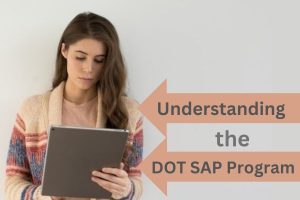When a DOT employee violates DOT drug and alcohol policies, they must go through Return-To-Duty Process. This includes a SAP evaluation and at least six observed, follow-up drug and/or alcohol tests.

The RTD process is more than just a regulatory requirement, it’s a structured way for employees to rebuild trust and regain eligibility in roles where public and operational safety are paramount.
When someone in a safety-sensitive role violates DOT drug and alcohol regulations, returning to work isn’t as simple as clocking back in. The structured Return-To-Duty process helps individuals address the violation and reenter their roles in a safe, responsible way.
The first step is a mandatory SAP evaluation, performed by a qualified specialist. This in-depth assessment identifies the severity of the individual’s substance use problem and outlines tailored recommendations for treatment. This step is critical to ensuring that the RTD process focuses on long-term workplace safety and compliance rather than punishment.
SAPs are also responsible for creating individualized programs that help workers overcome their substance use issues and re-establish their ability to safely perform their job duties. This includes recommending education and treatment courses, and ensuring that employees successfully complete them. In some cases, this may include inpatient treatment, outpatient treatment, or counseling.
In addition to assessing the effectiveness of treatment, SAPs must keep detailed records of their interactions with their clients. These are available to DOT officials during a safety investigation or for any other reason required by the DOT.
Once an employee completes their recommended program, they must pass a return-to-duty test to demonstrate their ability to safely perform their job in a safe manner. This test must be conducted under observation by a DOT-approved Medical Review Officer (MRO), and the MRO must report the positive result to the DOT Clearinghouse within 10 days. Following this, the individual must undergo unannounced follow-up testing based on the SAP’s recommendations, which can last up to five years. SRA Screening can handle steps 1-5 and step 7 of the RTD process with our reliable, high-quality drug screening services.
Evaluation
The evaluation process is a critical component of the return-to-duty process. It’s what determines whether an employee is ready to take the reins of a bus, sit in the cockpit of an airliner or work near the emergency control valves of a natural gas pipeline. The goal of the evaluation is to determine whether an individual has successfully completed a program designed to help them overcome substance abuse or addiction and will be able to resume their safety-sensitive duties.
During the evaluation, a qualified SAP will review an individual’s background and history and determine the best course of treatment. The SAP will then create a plan for education or treatment that is specific to the individual and their situation. This plan must include a minimum of 6 unannounced follow-up drug and alcohol tests, lasting up to 60 months.
Once the treatment plan is complete, the SAP will schedule a follow-up evaluation with the driver to see if they have successfully completed the program. If they have, the SAP will notify their employer and the follow-up testing can begin. The SAP will continue to monitor their progress throughout the follow-up testing period through direct check-ins or reports from the treatment providers.
When the follow-up tests are complete, a new evaluation will be conducted by the SAP to make sure that the individual has met all requirements and can return to their job duties. If a person fails the final evaluation or a follow-up test, they will be unable to resume their safety-sensitive job duties until they are re-evaluated by a DOT-qualified SAP and have a negative result on a return-to-duty drug and alcohol test. During the entire return-to-duty process, it is important for drivers and employers to keep in mind that these evaluations and treatments are confidential. It’s against federal regulations for an employer to share information about the evaluations or treatment with anyone who doesn’t need to know.
Education or Treatment
In some cases, a SAP will recommend specialized education or treatment programs. If you complete the program successfully and pass a DOT-compliant Return-To-Duty (RTD) test, you can resume your safety-sensitive duties. In most cases, you are responsible for the cost of the treatment or education program. Your employer will also be required to document your progress throughout the program and maintain all relevant records.
Once you have successfully completed the SAP-recommended educational or treatment program, the SAP will schedule a follow-up evaluation. This is a critical step in the RTD process as it determines whether you are ready to return to your job and safely operate commercial vehicles. It is important to remain in touch with your SAP and consistently follow through with all RTD testing requirements.
Your SAP will report your status to the FMCSA Clearinghouse. This is a major step in the New York CDL Return to Duty process because it officially gives you a green light from the federal government. Your SAP can also help you create a customized program that is tailored to your needs and the DOT guidelines.
The SAP will then create a plan for unannounced follow-up drug and alcohol testing, which lasts 1-5 years. You will have to submit to these tests, which must be negative, before you can resume your safety-sensitive duties.
You will have to continue to follow your SAP’s recommendations, attend any meetings, and perform all follow-up tests until you receive a final SAP report that states that you are safe to return to work and the violation has been cleared from the FMCSA Clearinghouse. You can then regain your driving privileges and return to your career with confidence.
Follow-Up Testing
Once an employee completes their treatment or education program as outlined by the SAP, they must successfully pass a return-to-duty test before returning to safety-sensitive work. Once they do, the SAP will usually require them to participate in a follow-up testing program. This is a series of unannounced observed tests that can last for up to five years.
While the follow-up testing doesn’t guarantee the employee’s safety, it does provide a level of accountability and ensure compliance with DOT regulations. Whether they’re behind the wheel of a bus, in the cockpit of an airplane, at the helm of a tanker or working on the emergency control valves of a natural gas pipeline, DOT SAP follow-up testing prevents relapse and keeps the worker out of harm’s way.
DOT SAP follow-up testing typically involves a structured series of unannounced directly observed drug and alcohol tests, which must be administered over a defined length of time. This testing plan is typically outlined by the SAP and can continue for up to five years. The SAP will select a testing schedule based on clinical best practices. In most cases, a driver will be required to have six directly observed tests each year.
The employer is responsible for implementing the testing plan as outlined by the SAP, and they must coordinate with third-party administrators or collection sites to administer these tests. Employers must also make sure they keep accurate records and report the results to the DOT as needed. If an employee fails a DOT SAP follow-up test or refuses to take one, they must restart the return-to-duty process and undergo a new evaluation by a qualified SAP. They will then be subject to the same testing requirements as before, including the requirement to have a positive RTD test result prior to returning to DOT-regulated duties.
Recordkeeping
When an employee in a safety-sensitive position violates workplace drug or alcohol regulations, they must follow a structured path to responsibly reclaim their role. The RTD process includes SAP evaluations, counseling, and rigorous testing. The goal is to help employees return to work safely and accountable, and it also safeguards employer compliance and builds trust.
A DOT-regulated employee who has been removed from their position due to a violation of DOT drug or alcohol rules is prohibited from returning to safety-sensitive duties until they’ve gone through the RTD process. Violations can include failing or refusing a required test, or being under the influence while performing a safety-sensitive job. In transit systems that operate under a “zero tolerance” policy, any refusal of a required test or violation of drug policies triggers the RTD process.
The RTD process begins with a mandatory removal from duties, and it continues with an assessment by a qualified SAP. The SAP will determine if the employee requires education or treatment, and then the employee must complete any recommended programs. Once the SAP has confirmed that the employee has successfully completed education or treatment, they must report this to their employer, and the employer must then schedule a RTD test.
After a successful RTD test, the employee must then undergo at least six unannounced drug and/or alcohol tests over the next year. The employee must also submit to an additional SAP evaluation, and the SAP must confirm that the driver is able to perform their safety-sensitive duties.
The RTD process can be difficult for employees, but it’s a necessary step to get back behind the wheel safely and responsibly. In addition to meeting compliance requirements, many employees who have successfully completed the process describe it as a transformative experience that helps them become more aware and accountable.


